Sri Lanka, often referred to as the "Pearl of the Indian Ocean," is a destination that truly has it all. From pristine beaches and lush jungles to ancient temples and vibrant cities, this island nation offers an incredible diversity of experiences. Planning a trip to Sri Lanka can feel overwhelming, especially if you’re aiming to explore the country in depth. That’s why we’ve created the perfect 1-month Sri Lanka itinerary to help you make the most of your time on this stunning island.
Whether you’re a nature lover, a history buff, a foodie, or an adventure seeker, this Sri Lanka itinerary has something for everyone. We’ll cover everything from how to plan your trip and where to stay on a budget to day-by-day activities and insider tips. By the end of this guide, you’ll have all the tools you need to create an unforgettable Sri Lanka adventure.
1 month Sri Lanka itinerary
Table of contents

Disclosure: Some links in this post are affiliate links. If you make a purchase through one of these links, we may earn a small commission (at no extra cost to you!). We're very grateful when you use our links to make a purchase:-).
How to Plan the Perfect Sri Lanka Trip
Planning a trip to Sri Lanka requires a bit of preparation, but it’s well worth the effort. Here are some key steps to help you get started:
- Decide on Your Travel Style: Are you a backpacker on a budget, a mid-range traveler, or someone seeking luxury? Sri Lanka caters to all types of travelers, so knowing your preferences will help you plan better.
- Choose the Right Time to Visit: Sri Lanka has two monsoon seasons, so the best time to visit depends on which part of the island you’re exploring. The west and south coasts are ideal from December to March, while the east coast shines from April to September.
- Create a Realistic Budget: Sri Lanka is affordable, but costs can add up if you’re not careful. A budget of 30–30–50 per day is realistic for most travelers.
- Book Accommodation in Advance: While you can find places to stay on the go, booking in advance ensures you get the best deals and availability.
- Plan Your Transportation: Sri Lanka’s public transport is cheap and reliable, but hiring a private driver or using trains for scenic routes can enhance your experience.
Sri Lanka 1 Month Itinerary: Map
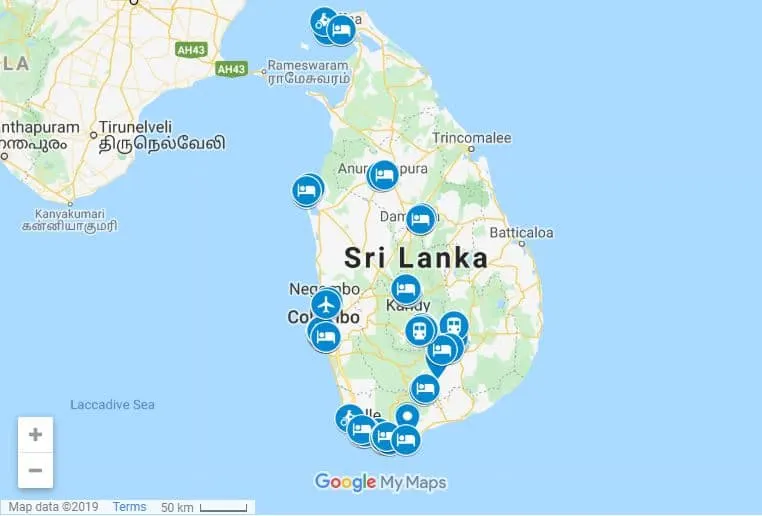
To help you visualize your journey, here’s a quick overview of the route covered in this 1-month Lanka itinerary:
- Negombo (Arrival)
- Colombo (Days 1–2)
- Galle (Days 3–5)
- Weligama (Days 6–8)
- Talalla (Days 9–10)
- Udawalawe National Park (Days 10–11)
- Ella (Days 12–15)
- Nuwara Eliya (Days 16–18)
- Kandy (Days 19–21)
- Sigiriya (Days 22–24)
- Anuradhapura (Days 25–27)
- Jaffna (Days 28–30)
- Negombo (Departure)
Sri Lanka One Month Itinerary: Summary

Here’s a quick summary of what your 1-month Lanka itinerary will look like:
- Week 1: Explore the cultural and coastal highlights of Negombo, Colombo, Galle, and Weligama.
- Week 2: Dive into wildlife adventures in Udawalawe, relax in Talalla, and hike through the hill country in Ella.
- Week 3: Discover the tea plantations of Nuwara Eliya, the cultural heart of Kandy, and the ancient ruins of Sigiriya.
- Week 4: Uncover the historical treasures of Anuradhapura and the unique charm of Jaffna before heading back to Negombo.
Find the best hotel deals for your next trip! Compare prices and book your stay on
Hostelworld: Meet fellow travellers — save on stays, Backpacker-friendly hostels, verified reviews and social stays that fit your budget and vibe.
Tripadvisor: Plan with confidence — reviews you can trust, Restaurants, hotels and experiences with millions of traveller reviews to help you choose what’s best.
Traveloka: Flights, hotels & more — simple booking, One-stop travel platform for great flight fares, hotel deals and local activities across Asia and beyond.
Day-by-Day Sri Lanka Itinerary
Day 1–2: Arrival in Negombo and Exploring Colombo
Your Sri Lanka adventure begins in Negombo, a bustling coastal town located just 10 kilometers from Bandaranaike International Airport. Negombo is often the first stop for travelers due to its proximity to the airport, and it’s a great place to ease into your trip. After a short stay in Negombo, you’ll head to Colombo, Sri Lanka’s vibrant capital, for two days of exploration.
Day 1: Arrival in Negombo

Highlights:
- Relax After Your Flight: Negombo is the perfect place to recover from a long flight. The town is known for its laid-back vibe, beautiful beaches, and lagoon.
- Explore the Dutch Canal: Take a leisurely stroll or a boat ride along the Dutch Canal, which dates back to the colonial era.
- Visit St. Mary’s Church: This stunning Catholic church is one of Negombo’s most iconic landmarks, featuring beautiful frescoes and architecture.
- Enjoy Fresh Seafood: Negombo is famous for its seafood. Head to a local restaurant or beachside shack to try dishes like grilled prawns, crab curry, or fish ambul thiyal (sour fish curry).
Where to Stay in Negombo:
- Budget: Villa Shade – A cozy guesthouse with a garden and affordable rooms.
- Mid-Range: Jetwing Beach – A beachfront hotel with modern amenities and a pool.
- Luxury: The Gateway Hotel – A luxurious option with stunning views of the Indian Ocean.
Day 2: Travel to Colombo and Explore the City
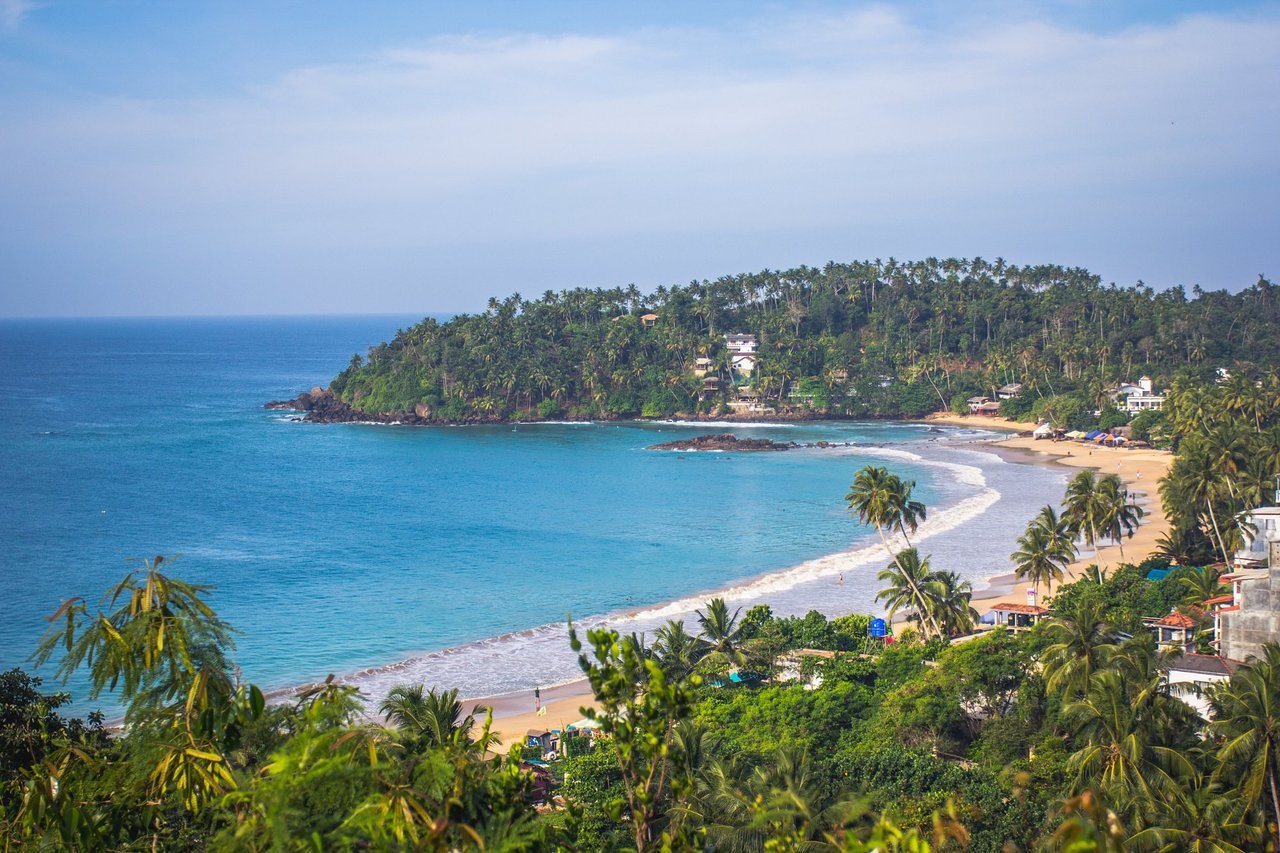
How to Get from Negombo to Colombo:
- By Taxi: A private taxi takes about 1 hour and costs around 20–20–30.
- By Bus: Public buses are the cheapest option, taking around 1.5 hours and costing less than $1.
Things to See in Colombo:
- Gangaramaya Temple: One of Colombo’s most famous Buddhist temples, featuring a mix of modern and traditional architecture, a museum, and a serene bo tree.
- Pettah Market: A bustling bazaar where you can find everything from spices and textiles to electronics and souvenirs. It’s a sensory overload but a must-visit for an authentic local experience.
- Galle Face Green: A scenic oceanfront promenade perfect for an evening stroll. Try some local street food like isso wade (shrimp fritters) or kottu roti from the vendors here.
- Independence Memorial Hall: A historic monument built to commemorate Sri Lanka’s independence from British rule in 1948.
- Colombo Fort Area: Explore the historic Fort district, home to colonial-era buildings, trendy cafes, and boutique shops.
Book top-rated tours and attractions on :
Viator (Best for curated global tours)
GetYourGuide (Skip-the-line tickets & local guides)
Klook (Great for Asia adventures & discounts)
Where to Stay in Colombo:
- Budget: Stay Lost & Found – A vibrant hostel with a social atmosphere, perfect for backpackers.
- Mid-Range: Clock Inn Colombo – A stylish boutique hotel with modern amenities.
- Luxury: Shangri-La Colombo – A 5-star hotel offering world-class service and stunning ocean views.
Tips for Exploring Colombo:
- Transportation: Use tuk-tuks for short distances, but always negotiate the fare beforehand.
- Food: Don’t miss trying Sri Lankan street food like kottu roti, hoppers, and egg roti.
- Safety: Colombo is generally safe, but keep an eye on your belongings, especially in crowded areas like Pettah Market.
Day 2 Evening: Sunset and Dinner
- Sunset at Galle Face Green: End your day with a relaxing sunset at Galle Face Green. Watch locals fly kites, enjoy the ocean breeze, and soak in the lively atmosphere.
- Dinner in Colombo: Head to a local restaurant like Ministry of Crab (if you’re splurging) or a more budget-friendly option like Nuga Gama for authentic Sri Lankan cuisine.
Why Spend Time in Negombo and Colombo?
Negombo and Colombo offer the perfect introduction to Sri Lanka. Negombo’s relaxed vibe helps you ease into your trip, while Colombo’s vibrant energy and cultural highlights give you a taste of the country’s rich heritage. These two days set the tone for the rest of your 1-month Lanka itinerary, blending relaxation, exploration, and cultural immersion.
Looking for cheap flights or all-in-one travel deals? Check out:
Trip.com (Competitive flight & hotel bundles)
Expedia (Flight + hotel savings)
WayAway.io (Cashback on flights & travel bookings)
Day 3–5: Exploring Galle and Around
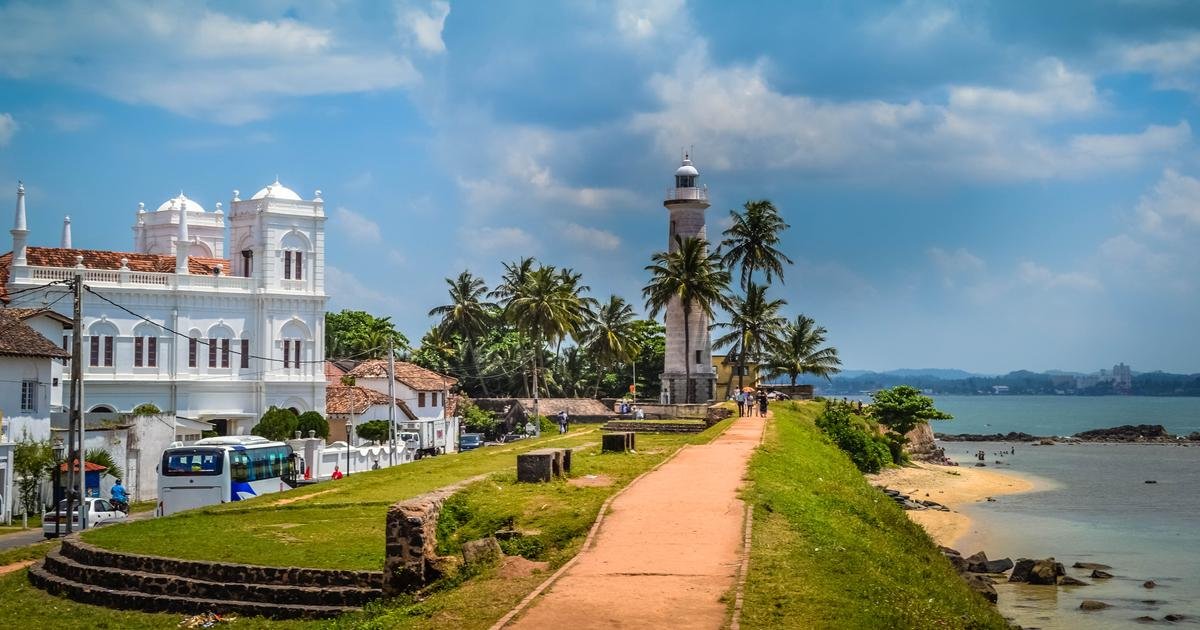
After soaking in the vibes of Negombo and Colombo, it’s time to head south to Galle, one of Sri Lanka’s most charming and historic destinations. Galle is a coastal city known for its UNESCO-listed Galle Fort, stunning beaches, and a mix of colonial and Sri Lankan culture. Over the next three days, you’ll explore the fort, relax on nearby beaches, and soak in the laid-back atmosphere of this beautiful region.
Day 3: Travel to Galle and Explore Galle Fort
How to Get from Colombo to Galle:
- By Train: The train ride from Colombo to Galle is one of the most scenic routes in Sri Lanka. It takes about 2.5 hours and costs around 3–3–5 for a second-class seat. Be sure to sit on the right side of the train for the best ocean views!
- By Bus: Public buses are cheaper (around $2) and take about 3 hours, depending on traffic.
- By Private Taxi: A taxi takes around 2 hours and costs approximately 40–40–50.
Highlights of Galle Fort:
- Galle Fort: This 16th-century fort, built by the Portuguese and later expanded by the Dutch, is a UNESCO World Heritage Site and the heart of Galle. Wander through its cobblestone streets, admire the colonial architecture, and explore its many boutique shops, cafes, and galleries.
- Galle Lighthouse: Located within the fort, this iconic lighthouse offers great photo opportunities and views of the ocean.
- Dutch Reformed Church: A historic church with beautiful stained-glass windows and a peaceful atmosphere.
- National Maritime Museum: Learn about Sri Lanka’s maritime history and the region’s connection to the sea.
- Ramparts Walk: Stroll along the fort’s ancient walls during sunset for breathtaking views of the Indian Ocean.
Where to Stay in Galle:
- Budget: The One Apartment – A cozy and affordable option located close to the fort.
- Mid-Range: Fort Bazaar – A boutique hotel with stylish rooms and a rooftop restaurant.
- Luxury: Amangalla – A luxurious heritage hotel offering an unforgettable stay within the fort.
Day 4: Day Trip to Unawatuna and Jungle Beach

Highlights:
- Unawatuna Beach: Just a 10-minute tuk-tuk ride from Galle, Unawatuna is one of Sri Lanka’s most famous beaches. Spend the day swimming, sunbathing, or enjoying water sports like snorkeling and paddleboarding.
- Jungle Beach: A short hike from Unawatuna, Jungle Beach is a hidden gem surrounded by lush greenery. It’s quieter than Unawatuna and perfect for a peaceful escape.
- Japanese Peace Pagoda: Located on Rumassala Hill, this serene Buddhist stupa offers panoramic views of the coastline. It’s a great spot for sunset.
Where to Eat in Unawatuna:
- Bedspace Kitchen: A popular spot for healthy meals, smoothie bowls, and fresh juices.
- Kingfisher Restaurant: Known for its seafood and beachfront location.
Day 5: Explore Mirissa and Secret Beach
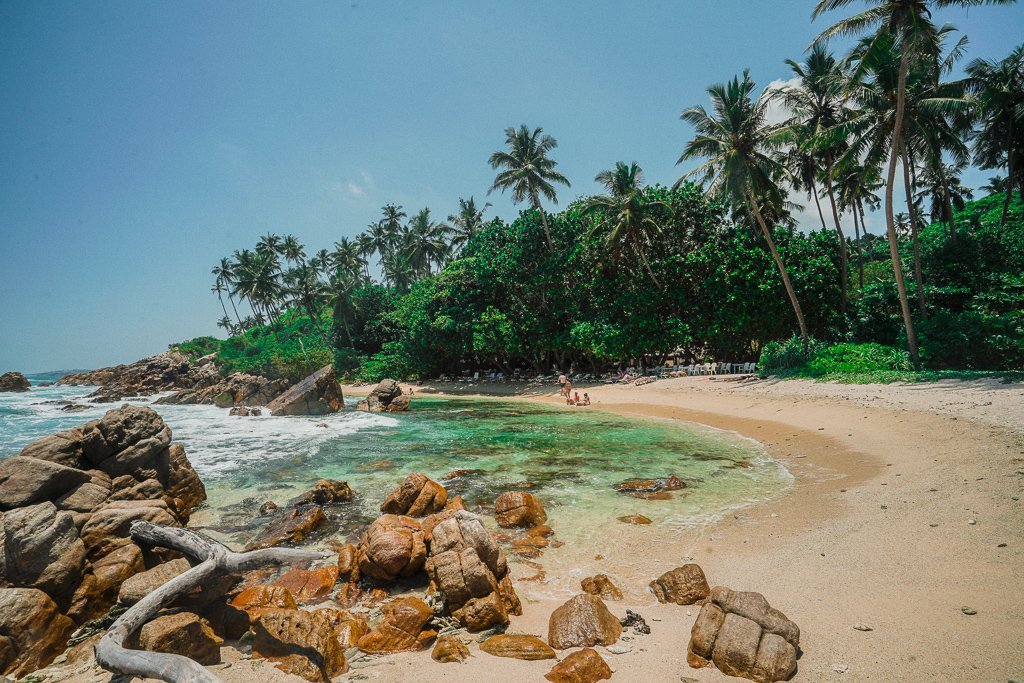
How to Get from Galle to Mirissa:
- By Tuk-Tuk: A 30-minute ride costing around 10–10–15.
- By Bus: Public buses are cheap (less than $1) and take about 45 minutes.
Highlights of Mirissa:
- Mirissa Beach: A laid-back beach town known for its golden sands, palm trees, and vibrant nightlife. Spend the day relaxing or trying water sports like surfing and kayaking.
- Secret Beach: A hidden beach located a short walk from Mirissa Beach. It’s quieter and perfect for a peaceful afternoon.
- Coconut Tree Hill: A short hike from Mirissa Beach, this spot offers stunning views of the coastline and is a popular Instagram spot.
Where to Stay in Mirissa:
- Budget: Mirissa Hostel – A social hostel with a pool and beach access.
- Mid-Range: Paradise Beach Club – A beachfront resort with comfortable rooms and a pool.
- Luxury: Cape Weligama – A luxurious retreat with stunning ocean views.
Tips for Exploring Galle and Around
- Best Time to Visit: December to April is the ideal time to visit Galle and the south coast, as the weather is dry and sunny.
- Transportation: Tuk-tuks are the most convenient way to get around Galle and nearby beaches. Always negotiate the fare beforehand.
- Food: Don’t miss trying local dishes like seafood curry, kottu roti, and hoppers. Many restaurants in Galle Fort offer a mix of Sri Lankan and international cuisine.
- Shopping: Galle Fort is a great place to shop for souvenirs, handmade jewelry, and batik clothing.
Why Spend Time in Galle and Around?
Galle and its surrounding areas offer a perfect blend of history, culture, and natural beauty. Whether you’re exploring the ancient fort, relaxing on pristine beaches, or enjoying fresh seafood, these three days will leave you enchanted by Sri Lanka’s south coast.
Find the best hotel deals for your next trip! Compare prices and book your stay on
Hostelworld: Meet fellow travellers — save on stays, Backpacker-friendly hostels, verified reviews and social stays that fit your budget and vibe.
Tripadvisor: Plan with confidence — reviews you can trust, Restaurants, hotels and experiences with millions of traveller reviews to help you choose what’s best.
Traveloka: Flights, hotels & more — simple booking, One-stop travel platform for great flight fares, hotel deals and local activities across Asia and beyond.
Day 6–8: Diving, Surfing, and Relaxing in Weligama
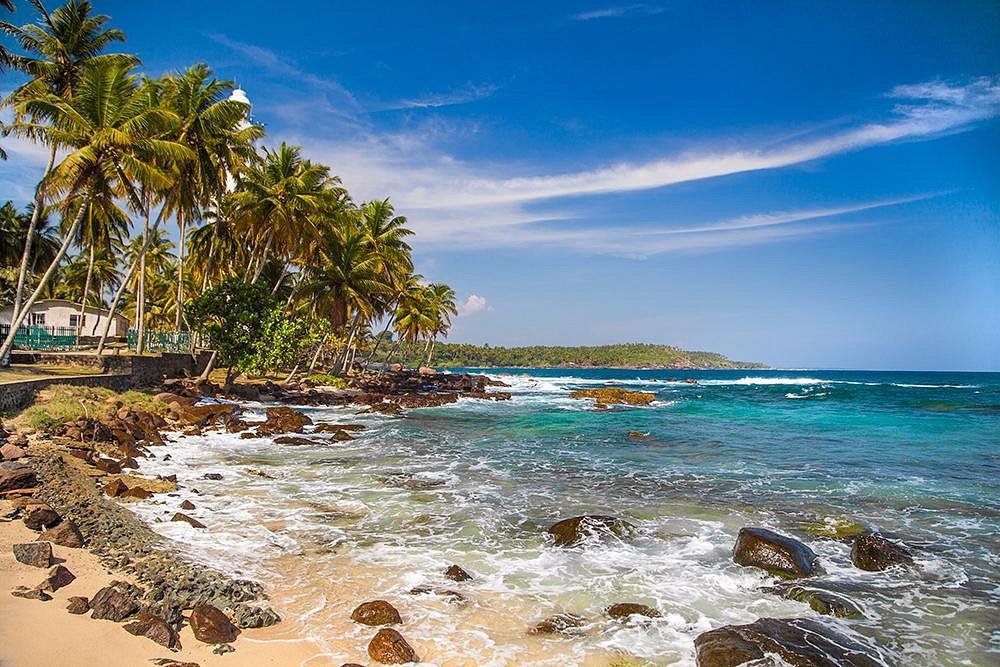
After exploring the historic charm of Galle and the laid-back beaches of Unawatuna and Mirissa, it’s time to head to Weligama, a coastal town known for its golden sands, excellent surfing conditions, and vibrant backpacker scene. Over the next three days, you’ll dive into water sports, relax on the beach, and soak in the bohemian vibe of this coastal paradise.
Day 6: Travel to Weligama and Explore the Town
How to Get from Galle/Mirissa to Weligama:
- By Tuk-Tuk: A 30-minute ride from Mirissa or a 1-hour ride from Galle, costing around 10–10–15.
- By Bus: Public buses are cheap (less than $1) and take about 45 minutes from Mirissa or 1.5 hours from Galle.
Highlights of Weligama:
- Weligama Beach: This long, crescent-shaped beach is perfect for swimming, sunbathing, and surfing. The calm waters near the shore make it ideal for beginners.
- Stilt Fishermen: Watch or even try your hand at the traditional stilt fishing technique, where fishermen perch on wooden stilts in the ocean.
- Taprobane Island: A small private island just off the coast of Weligama. You can walk to the island during low tide or take a boat ride to explore its lush greenery and colonial-era villa.
Where to Stay in Weligama:
- Budget: Tinara River Inn – A charming guesthouse with a peaceful riverside location.
- Mid-Range: Weligama Bay Marriott Resort & Spa – A beachfront resort with modern amenities and stunning views.
- Luxury: Cape Weligama – A luxurious retreat offering unparalleled ocean views and world-class service.
Day 7: Surfing and Water Sports
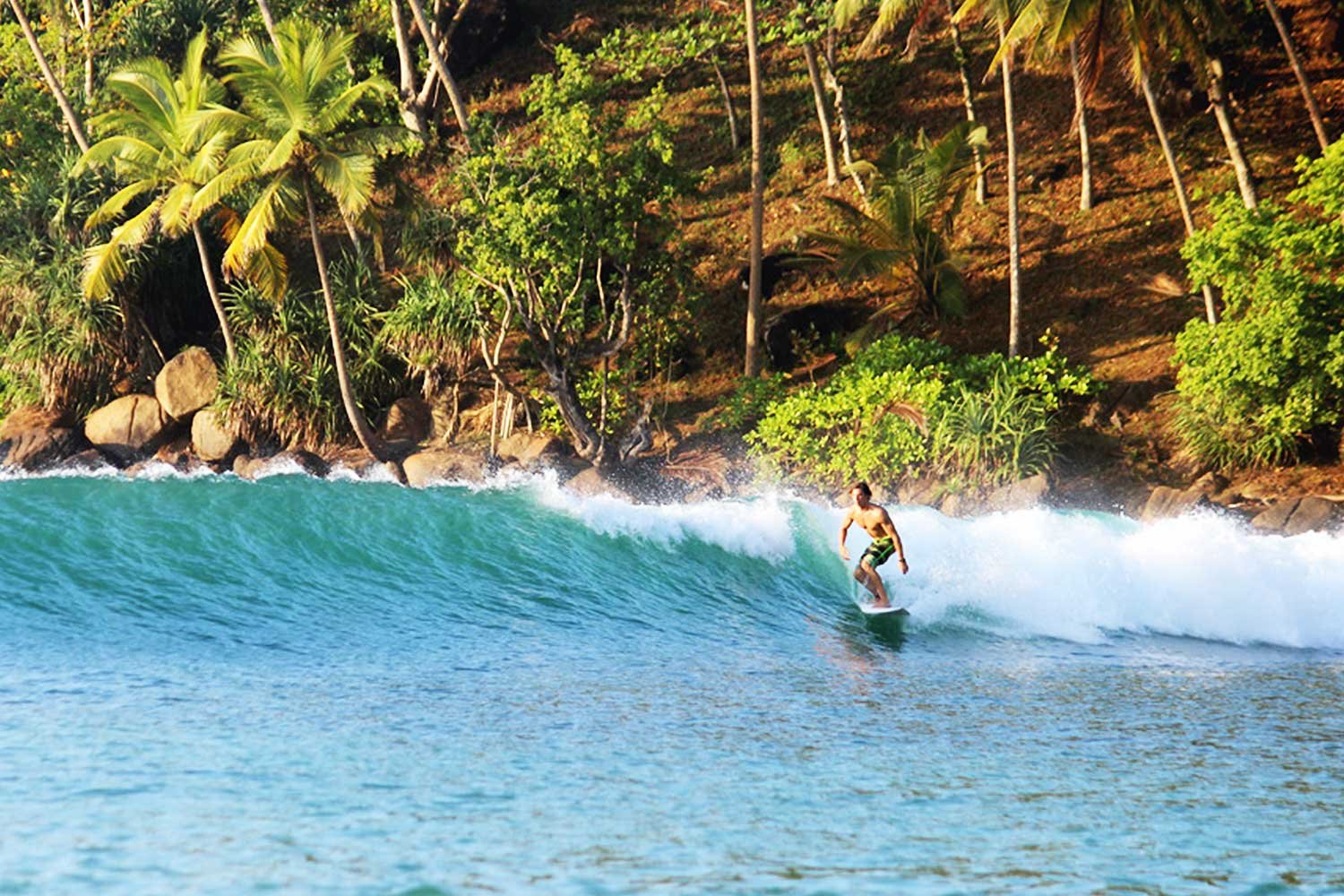
Highlights:
- Surfing Lessons: Weligama is one of the best places in Sri Lanka to learn how to surf. The gentle waves near the shore are perfect for beginners. You can book a 2-hour lesson for around 20–20–30, including equipment rental.
- Snorkeling and Diving: Explore the vibrant coral reefs and marine life around Weligama. Popular dive sites include Taprobane Island and Great Basses Reef. A half-day snorkeling trip costs around 20,while diving trips start at 20,while diving trips start at 50.
- Kayaking and Paddleboarding: Rent a kayak or paddleboard to explore the coastline at your own pace.
Where to Eat in Weligama:
- The Shack Beach Cafe: A popular spot for healthy meals, smoothie bowls, and fresh juices.
- Fellini Italian Restaurant: Known for its delicious wood-fired pizzas and pasta dishes.
- Handunugoda Tea Estate Cafe: A unique cafe where you can sample rare and exotic teas.
Day 8: Relaxing and Exploring Nearby Attractions
Highlights:
- Mirissa (Day Trip): If you missed Mirissa earlier, take a short tuk-tuk ride to explore its beaches, Coconut Tree Hill, and Secret Beach.
- Polhena Beach: A quieter beach located just south of Weligama, perfect for swimming and snorkeling.
- Kushta Raja Gala: A large rock formation near Weligama Beach, offering great views of the coastline.
Evening in Weligama:
- Sunset at Weligama Beach: End your day with a relaxing sunset on the beach. Many beachfront bars and restaurants offer happy hour deals, making it the perfect time to enjoy a cocktail.
- Nightlife: Weligama has a lively backpacker scene, with beach parties and live music events happening regularly. Check out Hangtime Hostel or The Loft for a fun night out.
Tips for Exploring Weligama
- Best Time to Visit: December to April is the ideal time to visit Weligama, as the weather is dry and the waves are perfect for surfing.
- Transportation: Tuk-tuks are the most convenient way to get around Weligama and nearby attractions. Always negotiate the fare beforehand.
- Safety: While Weligama is generally safe, be cautious when swimming or surfing, especially during high tide. Always follow the instructions of your surf instructor or guide.
- Packing Tips: Don’t forget to pack sunscreen, a hat, and a reusable water bottle to stay hydrated.
Why Spend Time in Weligama?
Weligama is the perfect destination for water sports enthusiasts, beach lovers, and anyone looking to relax in a laid-back coastal town. Whether you’re catching your first wave, exploring vibrant coral reefs, or simply soaking in the sun, these three days in Weligama will leave you feeling refreshed and rejuvenated.
Day 9–10: Relaxing in Talalla
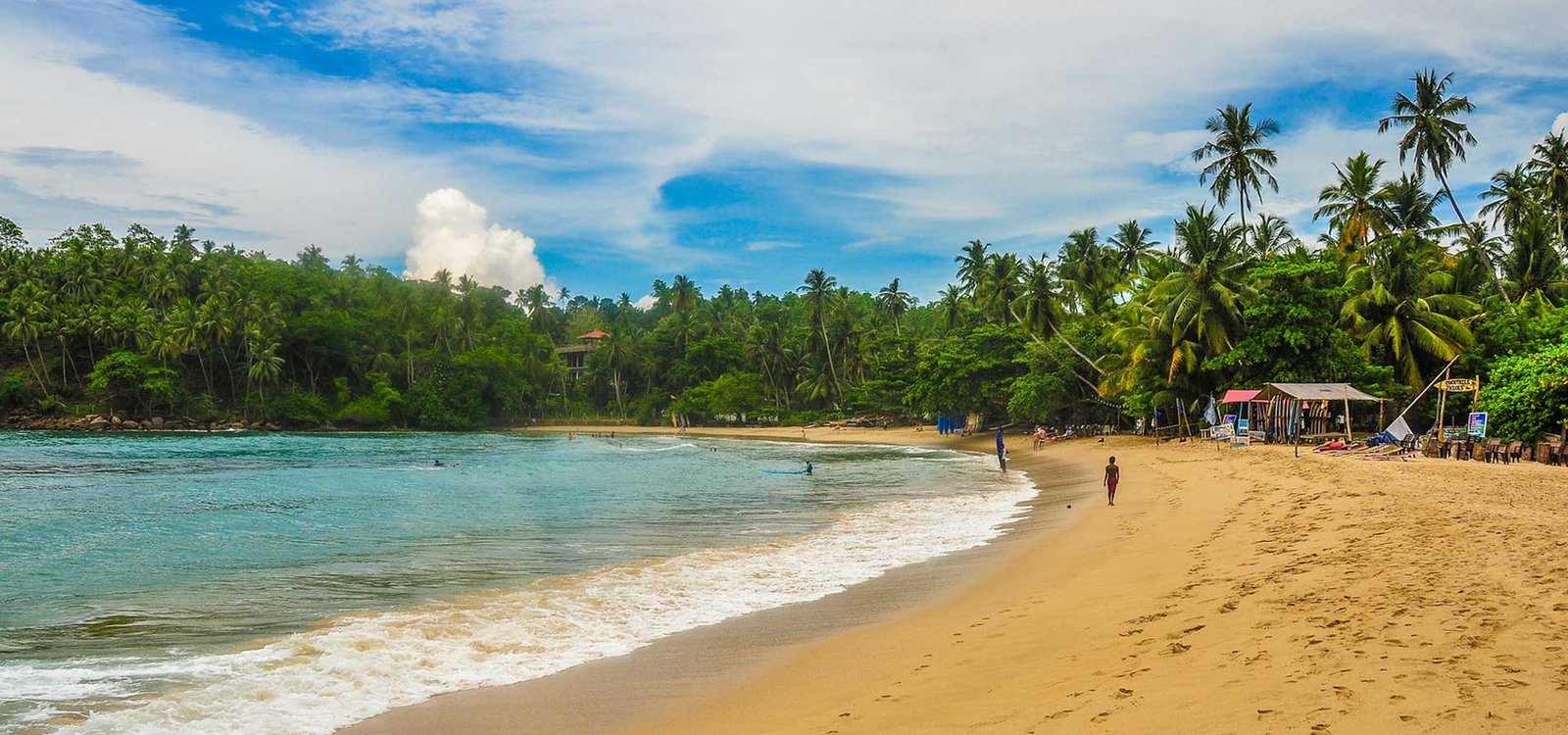
After the vibrant energy of Weligama, it’s time to slow down and unwind in Talalla, a hidden gem along Sri Lanka’s south coast. Known for its pristine beaches, tranquil atmosphere, and lush surroundings, Talalla is the perfect place to relax, recharge, and enjoy the natural beauty of Sri Lanka. Over the next two days, you’ll soak in the serenity of this coastal paradise, indulge in yoga and wellness activities, and explore the untouched beauty of the area.
Day 9: Travel to Talalla and Settle In
How to Get from Weligama to Talalla:
- By Tuk-Tuk: A 30-minute ride costing around 10–10–15.
- By Bus: Public buses are cheap (less than $1) and take about 45 minutes.
Highlights of Talalla:
- Talalla Beach: This stunning, uncrowded beach is perfect for swimming, sunbathing, and long walks along the shore. The calm waters and golden sands make it an ideal spot for relaxation.
- Talalla Surf Point: If you’re looking to continue your surfing journey, Talalla offers gentle waves that are perfect for beginners and intermediate surfers.
- Talalla Retreat: A wellness-focused resort offering yoga classes, Ayurvedic treatments, and healthy meals. Even if you’re not staying here, you can book a day pass to enjoy their facilities.
Where to Stay in Talalla:
- Budget: Talalla Beach House – A cozy and affordable option with ocean views.
- Mid-Range: Talalla Surf Camp – A surf-focused retreat with comfortable accommodations and a laid-back vibe.
- Luxury: Talalla Retreat – A luxurious wellness resort offering yoga, spa treatments, and gourmet meals.
Day 10: Wellness and Exploration
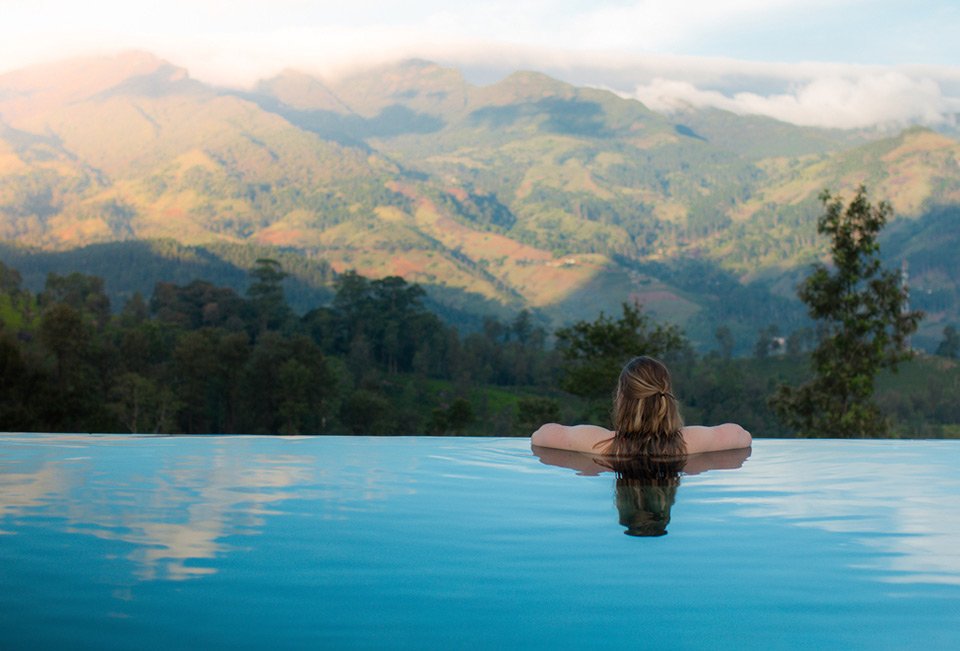
Highlights:
- Yoga and Meditation: Start your day with a yoga session on the beach or at one of the local retreats. Talalla is known for its wellness offerings, and many accommodations provide daily yoga classes.
- Ayurvedic Treatments: Indulge in a relaxing Ayurvedic massage or treatment to rejuvenate your body and mind.
- Explore the Surrounding Area: Take a tuk-tuk ride to nearby attractions like Hummanaya Blow Hole (the second-largest blowhole in the world) or Dikwella Beach, another beautiful and less-crowded beach.
- Sunset at Talalla Beach: End your day with a breathtaking sunset on the beach. The peaceful atmosphere and stunning views make it a memorable experience.
Where to Eat in Talalla:
- Talalla Retreat Restaurant: Offers healthy and delicious meals made with fresh, local ingredients.
- The Beach House Cafe: A casual beachfront cafe serving Sri Lankan and international dishes.
- Local Eateries: Try small local restaurants for authentic Sri Lankan rice and curry or fresh seafood.
Tips for Exploring Talalla
- Best Time to Visit: December to April is the ideal time to visit Talalla, as the weather is dry and sunny.
- Transportation: Tuk-tuks are the most convenient way to get around Talalla and nearby attractions. Always negotiate the fare beforehand.
- Packing Tips: Don’t forget to pack a yoga mat if you plan to practice on the beach, as well as sunscreen, a hat, and a reusable water bottle.
- Wellness Activities: Many accommodations in Talalla offer wellness packages, so consider booking in advance to secure your spot.
Why Spend Time in Talalla?
Talalla is the perfect destination for travelers seeking peace, relaxation, and a connection with nature. Whether you’re practicing yoga on the beach, enjoying an Ayurvedic treatment, or simply soaking in the serene atmosphere, these two days in Talalla will leave you feeling refreshed and rejuvenated.
Day 10–11: Safari at Udawalawe National Park
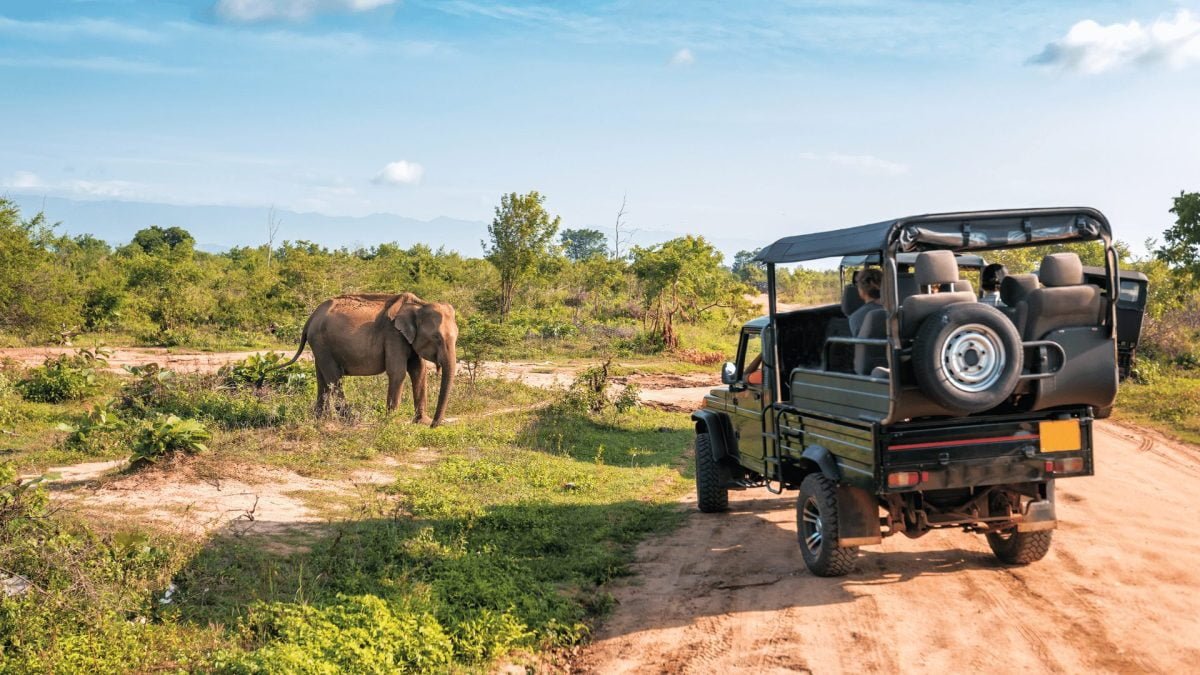
After the serene beaches of Talalla, it’s time to swap the ocean for the jungle and embark on an unforgettable wildlife adventure at Udawalawe National Park. Known for its large population of elephants, diverse wildlife, and stunning landscapes, Udawalawe is one of Sri Lanka’s most popular safari destinations. Over the next two days, you’ll explore the park, spot incredible animals, and immerse yourself in the natural beauty of Sri Lanka’s wilderness.
Book top-rated tours and attractions on :
Viator (Best for curated global tours)
GetYourGuide (Skip-the-line tickets & local guides)
Klook (Great for Asia adventures & discounts)
Day 10: Travel to Udawalawe and Afternoon Safari
How to Get from Talalla to Udawalawe:
- By Private Taxi: A 2.5-hour drive costing around 40–40–50.
- By Bus and Tuk-Tuk: Take a bus to Matara (1 hour), then another bus to Udawalawe (2 hours), and finally a tuk-tuk to your accommodation (15 minutes). This option is cheaper but less convenient.
Highlights of Udawalawe National Park:
- Elephant Sightings: Udawalawe is home to over 500 elephants, making it one of the best places in Sri Lanka to see these majestic creatures in the wild.
- Diverse Wildlife: In addition to elephants, the park is home to water buffalo, crocodiles, monkeys, peacocks, and a variety of bird species. If you’re lucky, you might even spot a leopard or sloth bear!
- Scenic Landscapes: The park features a mix of grasslands, forests, and the Udawalawe Reservoir, creating a stunning backdrop for your safari.
Afternoon Safari:
- Most safari tours start in the early morning or late afternoon when animals are most active. Book a 3–4 hour jeep safari through your accommodation or a local tour operator.
- A private safari costs around 40–40–50 per jeep (which can seat up to 6 people), while shared safaris are cheaper at around 15–15–20 per person.
Where to Stay Near Udawalawe:
- Budget: Grand Udawalawe Safari Resort – A budget-friendly option with comfortable rooms and easy access to the park.
- Mid-Range: Kalu’s Hideaway – A charming eco-lodge with a pool and lush surroundings.
- Luxury: Jetwing Udawalawe – A luxurious resort offering spacious rooms and excellent service.
Day 11: Morning Safari and Travel to Ella
Morning Safari:
- Start your day early with a sunrise safari. The cool morning air and soft light make it the best time to spot wildlife.
- After your safari, enjoy breakfast at your accommodation before heading to your next destination.
How to Get from Udawalawe to Ella:
- By Train: Take a tuk-tuk to Udawalawe Railway Station (15 minutes), then catch a train to Ella (3–4 hours). The train ride is scenic and affordable, with tickets costing around 2–2–5.
- By Private Taxi: A 2.5-hour drive costing around 40–40–50.
Tips for Exploring Udawalawe National Park
- Best Time to Visit: Early morning or late afternoon safaris offer the best chances of spotting wildlife.
- What to Bring: Wear neutral-colored clothing, bring a hat, sunscreen, and insect repellent, and don’t forget your camera!
- Guides: Hiring a knowledgeable guide can enhance your safari experience by helping you spot animals and sharing interesting facts about the park.
- Respect Wildlife: Always maintain a safe distance from animals and avoid feeding or disturbing them.
Why Spend Time in Udawalawe?
Udawalawe National Park offers a unique opportunity to experience Sri Lanka’s incredible wildlife up close. Whether you’re marveling at a herd of elephants, spotting exotic birds, or simply enjoying the park’s natural beauty, these two days will be a highlight of your 1-month Lanka itinerary.
Day 12–15: Hiking and Exploring Ella
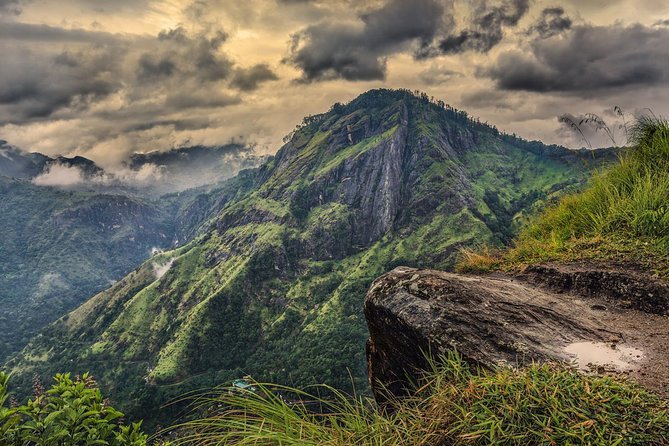
After the thrilling wildlife adventures of Udawalawe, it’s time to head to Ella, a charming hill country town known for its lush greenery, stunning waterfalls, and breathtaking views. Nestled in the central highlands of Sri Lanka, Ella is a haven for nature lovers, hikers, and anyone looking to escape the heat of the lowlands. Over the next four days, you’ll explore Ella’s iconic landmarks, hike through scenic trails, and soak in the laid-back vibe of this picturesque town.
Day 12: Travel to Ella and Explore the Town
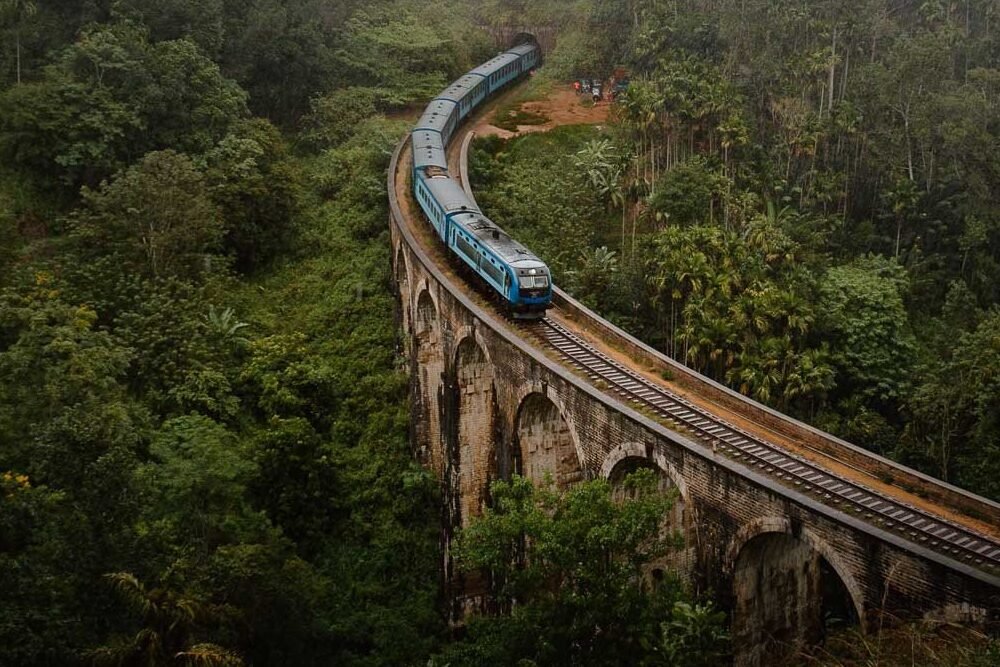
How to Get from Udawalawe to Ella:
Need a ride? Book airport transfers, taxis, or rental cars easily:
Kiwitaxi (Reliable private transfers worldwide)
Rentalcars.com (Compare car rentals for the best price)
- By Train: Take a tuk-tuk to Udawalawe Railway Station (15 minutes), then catch a train to Ella (3–4 hours). The train ride is one of the most scenic in Sri Lanka, passing through tea plantations, tunnels, and mountains. Tickets cost around 2–2–5 for second class.
- By Private Taxi: A 2.5-hour drive costing around 40–40–50.
Highlights of Ella:
- Nine Arches Bridge: This iconic railway bridge, surrounded by lush greenery, is a must-visit. Time your visit to watch a train pass over the bridge for a magical photo opportunity.
- Little Adam’s Peak: A relatively easy hike (about 1–2 hours round trip) offering panoramic views of Ella’s hills and valleys. The trail is well-marked and suitable for all fitness levels.
- Ella Town: Stroll through the town’s charming streets, browse local shops, and enjoy a cup of Ceylon tea at a cozy cafe.
Where to Stay in Ella:
- Budget: Chillout Hostel Ella – A social hostel with a relaxed vibe and stunning views.
- Mid-Range: 98 Acres Resort & Spa – A luxurious eco-resort with panoramic views of Ella Gap.
- Luxury: Ella Jungle Resort – A unique treehouse-style resort nestled in the jungle.
Day 13: Hiking and Waterfalls
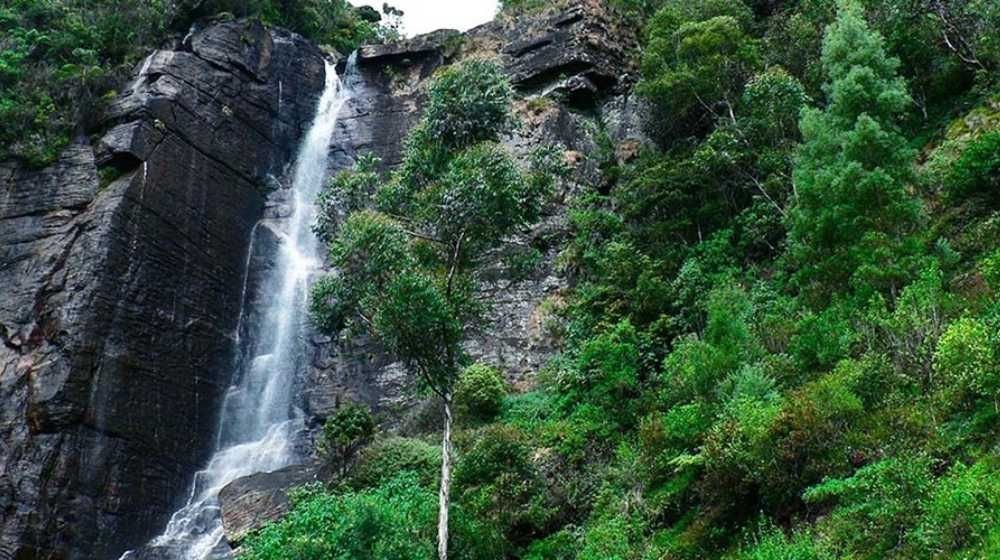
Highlights:
- Ella Rock: A more challenging hike (3–4 hours round trip) that rewards you with breathtaking views of the surrounding hills and valleys. The trail starts near Ella Railway Station and passes through tea plantations and forests.
- Ravana Falls: One of Sri Lanka’s most famous waterfalls, located just a short drive from Ella. You can swim in the natural pools at the base of the falls or simply admire the view.
- Diyaluma Falls: If you’re up for an adventure, take a day trip to Diyaluma Falls, the second-highest waterfall in Sri Lanka. The hike to the top offers stunning views and natural infinity pools to swim in.
Where to Eat in Ella:
- Cafe Chill: A popular spot for Western and Sri Lankan dishes, with a relaxed atmosphere and great views.
- Matey Hut: Known for its delicious and affordable rice and curry.
- AK Ristoro: A cozy Italian restaurant offering wood-fired pizzas and homemade pasta.
Day 14: Scenic Train Ride to Nuwara Eliya
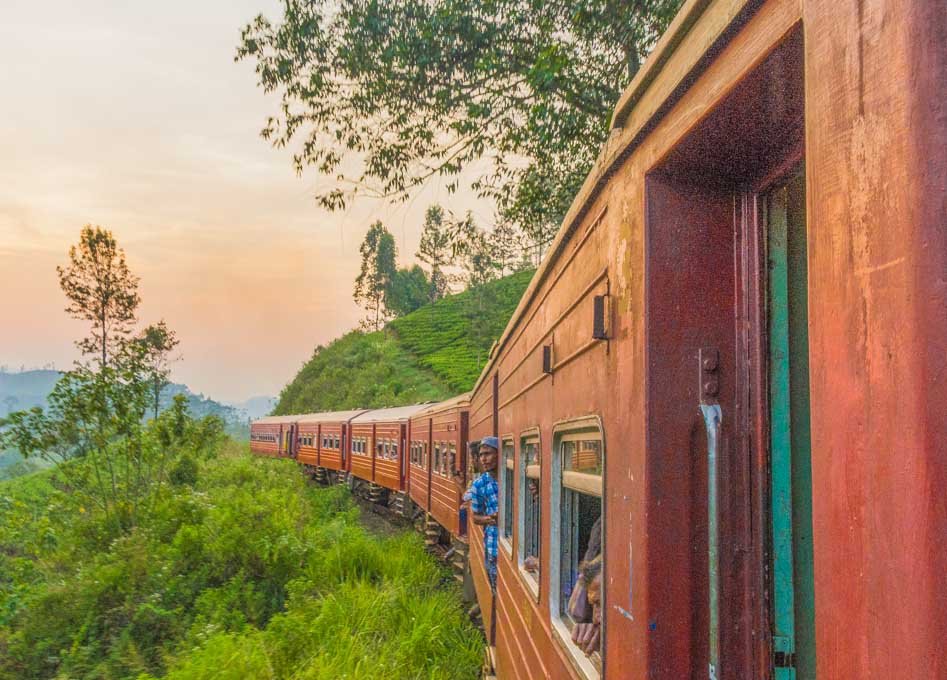
Highlights:
- Ella to Nuwara Eliya Train Ride: Often called one of the most beautiful train rides in the world, this journey takes you through tea plantations, misty mountains, and charming villages. The ride takes about 2.5 hours and costs around 2–2–5 for second class.
- Tea Plantation Tour: Visit a tea factory in Nuwara Eliya to learn about the tea-making process and sample some of Sri Lanka’s finest Ceylon tea.
- Gregory Lake: A scenic lake in Nuwara Eliya where you can enjoy a boat ride or a leisurely stroll.
Where to Stay in Nuwara Eliya:
- Budget: Trevene – A cozy guesthouse with a homely atmosphere.
- Mid-Range: Heritance Tea Factory – A unique hotel set in a converted tea factory.
- Luxury: The Grand Hotel – A colonial-era hotel offering luxurious accommodations.
Day 15: Return to Ella and Relax
Highlights:
- Relax in Ella: Spend your final day in Ella relaxing at your accommodation, exploring local cafes, or shopping for souvenirs.
- Evening at Nine Arches Bridge: Return to the Nine Arches Bridge in the evening to watch the sunset and capture the bridge in a different light.
Tips for Exploring Ella
- Best Time to Visit: December to April is the ideal time to visit Ella, as the weather is dry and pleasant.
- Hiking Tips: Wear comfortable shoes, bring plenty of water, and start early to avoid the midday heat.
- Transportation: Tuk-tuks are the most convenient way to get around Ella and nearby attractions. Always negotiate the fare beforehand.
- Packing Tips: Don’t forget to pack a rain jacket, as the weather in the hill country can be unpredictable.
Why Spend Time in Ella?
Ella is a paradise for nature lovers and adventure seekers. Whether you’re hiking to stunning viewpoints, chasing waterfalls, or simply enjoying the laid-back vibe of the town, these four days in Ella will leave you with unforgettable memories.
Day 16–18: Tea Plantations in Nuwara Eliya

After the lush greenery and scenic hikes of Ella, it’s time to head to Nuwara Eliya, a charming hill station known as the heart of Sri Lanka’s tea country. Often referred to as "Little England" due to its colonial architecture and cool climate, Nuwara Eliya is a haven for tea lovers, nature enthusiasts, and those seeking a tranquil escape. Over the next three days, you’ll explore sprawling tea plantations, visit historic landmarks, and soak in the town’s unique charm.
Day 16: Travel to Nuwara Eliya and Explore the Town
How to Get from Ella to Nuwara Eliya:
- By Train: The scenic train ride from Ella to Nuwara Eliya takes about 2.5 hours and costs around 2–2–5 for second class. Be sure to sit on the right side of the train for the best views of tea plantations and waterfalls.
- By Private Taxi: A 2-hour drive costing around 40–40–50.
Highlights of Nuwara Eliya:
- Victoria Park: A beautifully maintained park in the center of town, perfect for a leisurely stroll or a picnic. The park is especially vibrant during the spring when flowers are in full bloom.
- Gregory Lake: A scenic lake where you can enjoy boating, horse riding, or simply relax by the water. The surrounding area is great for a walk or bike ride.
- Colonial Architecture: Explore the town’s colonial-era buildings, including the iconic Grand Hotel and the Post Office, which dates back to the British era.
Where to Stay in Nuwara Eliya:
- Budget: Trevene – A cozy guesthouse with a homely atmosphere.
- Mid-Range: Heritance Tea Factory – A unique hotel set in a converted tea factory.
- Luxury: The Grand Hotel – A colonial-era hotel offering luxurious accommodations.
Day 17: Tea Plantation Tour and Waterfalls
Highlights:
- Tea Plantation Tour: Visit a working tea factory, such as Pedro Tea Estate or Bluefield Tea Gardens, to learn about the tea-making process from leaf to cup. Enjoy a guided tour of the factory and sample some of Sri Lanka’s finest Ceylon tea.
- Lover’s Leap Waterfall: A picturesque waterfall located near Pedro Tea Estate. The short hike to the falls offers stunning views of the surrounding tea plantations.
- St. Clair’s Falls: Known as the "Little Niagara of Sri Lanka," this waterfall is one of the widest in the country. It’s located about 30 minutes from Nuwara Eliya and is a great spot for photos.
Where to Eat in Nuwara Eliya:
- Grand Indian: A popular restaurant serving delicious Indian cuisine.
- Milano Restaurant: Known for its Italian dishes and cozy atmosphere.
- Hill Club: A colonial-style restaurant offering a fine dining experience.
Day 18: Day Trip to Horton Plains National Park
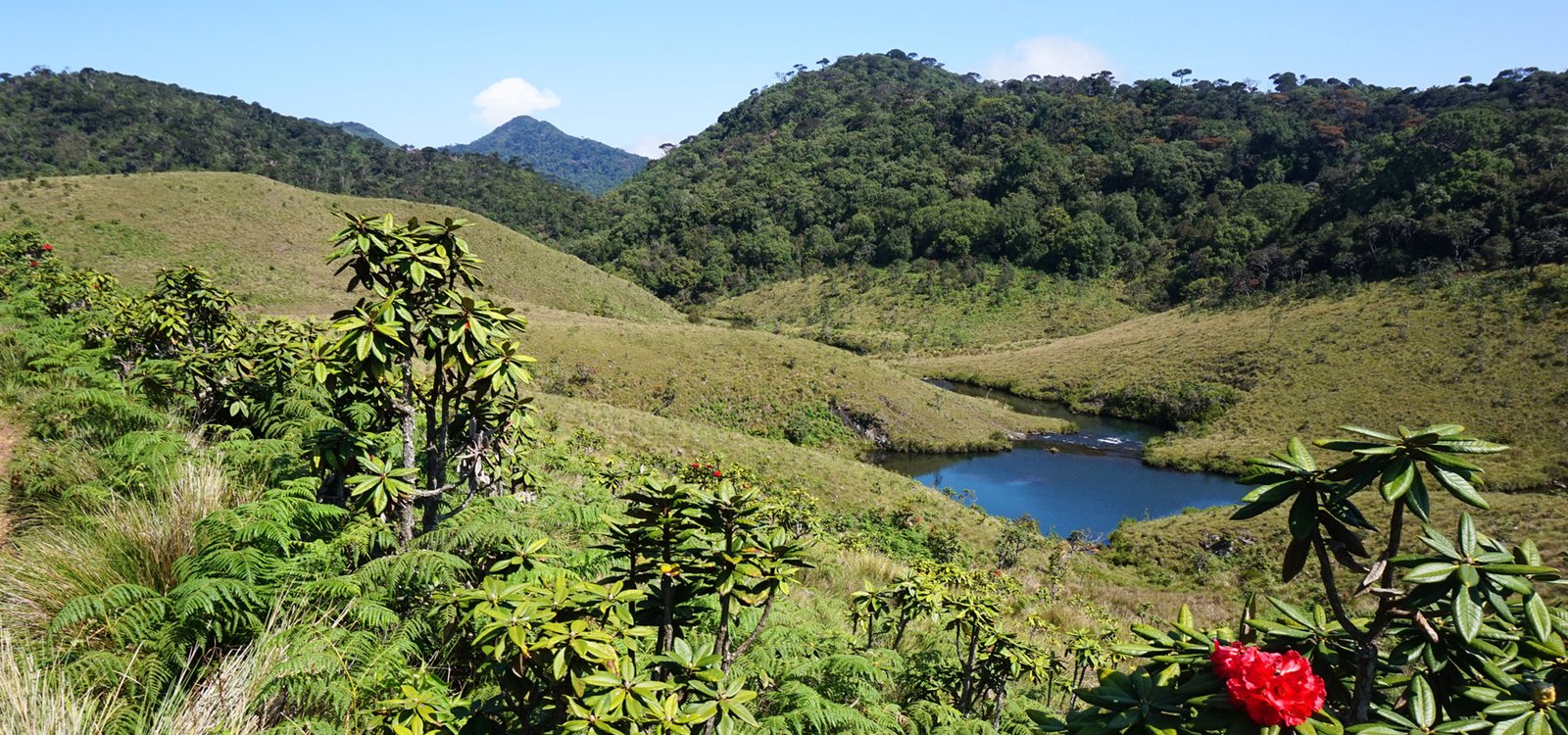
Highlights:
- Horton Plains National Park: A UNESCO World Heritage Site and one of Sri Lanka’s most beautiful natural reserves. The park is known for its rolling grasslands, misty landscapes, and diverse wildlife.
- World’s End: A dramatic cliff with a sheer drop of about 880 meters, offering breathtaking views of the surrounding plains and valleys. Visit early in the morning to avoid clouds obstructing the view.
- Baker’s Falls: A stunning waterfall located within the park, accessible via a short hike.
How to Get to Horton Plains:
- By Private Taxi: A 1-hour drive costing around 30–30–40.
- By Tuk-Tuk: A cheaper but slower option, taking about 1.5 hours.
Tips for Visiting Horton Plains:
- Start Early: The park opens at 6 AM, and it’s best to arrive early to enjoy clear views at World’s End.
- What to Bring: Wear comfortable hiking shoes, bring a rain jacket, and pack snacks and water.
- Entry Fees: The entrance fee for Horton Plains is around $15 per person.
Tips for Exploring Nuwara Eliya
- Best Time to Visit: March to May is the ideal time to visit Nuwara Eliya, as the weather is cool and pleasant.
- Transportation: Tuk-tuks and private taxis are the most convenient ways to get around Nuwara Eliya and nearby attractions.
- Packing Tips: Bring warm clothing, as temperatures in Nuwara Eliya can drop significantly, especially in the evenings.
- Respect Local Culture: Nuwara Eliya is a conservative town, so dress modestly when visiting religious or cultural sites.
Why Spend Time in Nuwara Eliya?
Nuwara Eliya offers a unique blend of natural beauty, colonial charm, and cultural heritage. Whether you’re sipping tea at a plantation, hiking through misty landscapes, or exploring historic landmarks, these three days in Nuwara Eliya will leave you enchanted by Sri Lanka’s hill country.
Day 19–21: Cultural Immersion in Kandy

After the cool, misty hills of Nuwara Eliya, it’s time to head to Kandy, Sri Lanka’s cultural capital and a UNESCO World Heritage city. Nestled in the central highlands and surrounded by lush mountains, Kandy is a city steeped in history, spirituality, and tradition. Over the next three days, you’ll explore ancient temples, stroll around a serene lake, and immerse yourself in the vibrant culture of this enchanting city.
Day 19: Travel to Kandy and Explore the City
How to Get from Nuwara Eliya to Kandy:
- By Train: The train ride from Nuwara Eliya to Kandy takes about 4 hours and is one of the most scenic routes in Sri Lanka. Tickets cost around 3–3–5 for second class.
- By Private Taxi: A 3-hour drive costing around 50–50–60.
Highlights of Kandy:
- Temple of the Tooth Relic (Sri Dalada Maligawa): This sacred Buddhist temple houses a relic of the Buddha’s tooth and is one of the most important religious sites in Sri Lanka. Witness the daily rituals and explore the temple’s beautiful architecture.
- Kandy Lake: A serene man-made lake located in the heart of the city. Take a leisurely stroll around the lake or relax on one of the benches while enjoying the views.
- Kandy Market: Explore the bustling local market to shop for fresh produce, spices, and souvenirs. It’s a great place to experience the daily life of locals.
Where to Stay in Kandy:
- Budget: Clock Inn Kandy – A stylish and affordable hostel with a social atmosphere.
- Mid-Range: Earl’s Regent – A comfortable hotel with panoramic views of the surrounding hills.
- Luxury: Theva Residency – A boutique hotel offering luxurious accommodations and stunning views.
Day 20: Cultural Experiences and Day Trips
Highlights:
- Cultural Show: Attend a traditional Kandyan dance performance at the Kandy Cultural Centre. The show features vibrant costumes, drumming, and fire dancing, offering a glimpse into Sri Lanka’s rich cultural heritage.
- Royal Botanical Gardens (Peradeniya): Located about 30 minutes from Kandy, these gardens are home to a stunning collection of orchids, palm trees, and other tropical plants. Don’t miss the giant Java fig tree, which is over 100 years old.
- Bahiravokanda Vihara Buddha Statue: A massive white Buddha statue located on a hill overlooking Kandy. The climb to the statue offers panoramic views of the city.
Where to Eat in Kandy:
- The Kandy Garden Cafe: A cozy cafe offering a mix of Sri Lankan and Western dishes.
- Devon Restaurant: Known for its delicious rice and curry and traditional Sri Lankan sweets.
- Slightly Chilled Lounge Bar: A great spot for drinks and light bites with a view of Kandy Lake.
Day 21: Explore More of Kandy and Relax
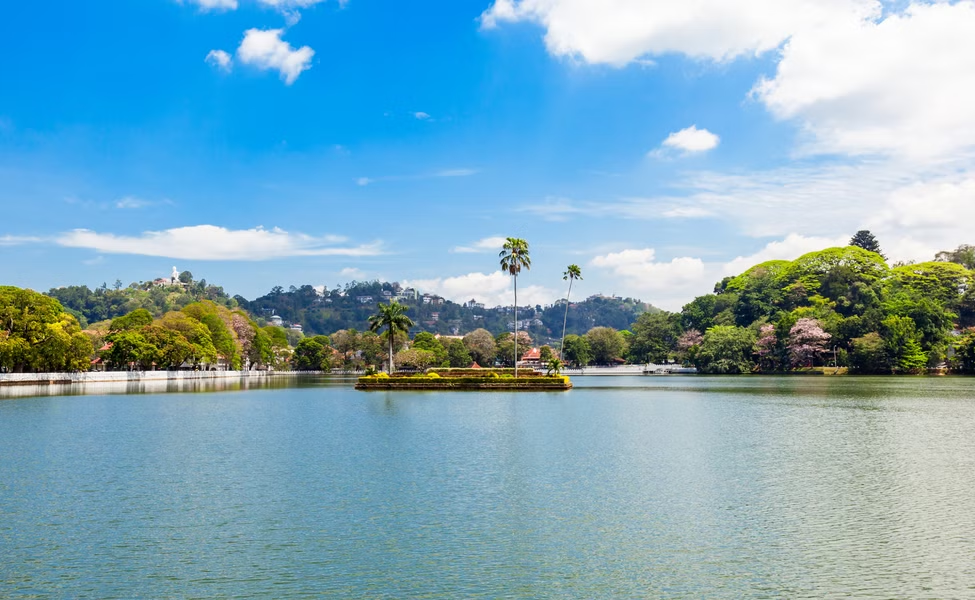
Highlights:
- Udawatta Kele Sanctuary: A peaceful forest reserve located near the Temple of the Tooth Relic. It’s a great place for a morning walk or birdwatching.
- Gem Museum and Workshop: Learn about Sri Lanka’s famous gem industry and shop for high-quality gems and jewelry.
- Evening at Kandy Lake: Spend your final evening in Kandy relaxing by the lake or enjoying a sunset boat ride.
Tips for Exploring Kandy
- Best Time to Visit: December to April is the ideal time to visit Kandy, as the weather is dry and pleasant.
- Transportation: Tuk-tuks and taxis are the most convenient ways to get around Kandy. Always negotiate the fare beforehand.
- Dress Code: When visiting religious sites like the Temple of the Tooth Relic, dress modestly and remove your shoes before entering.
- Packing Tips: Bring comfortable walking shoes, a hat, and sunscreen for exploring the city.
Why Spend Time in Kandy?
Kandy is a city that beautifully blends history, culture, and natural beauty. Whether you’re exploring ancient temples, enjoying a cultural show, or simply relaxing by the lake, these three days in Kandy will leave you with a deep appreciation for Sri Lanka’s rich heritage.
Day 22–24: Ancient Ruins in Sigiriya
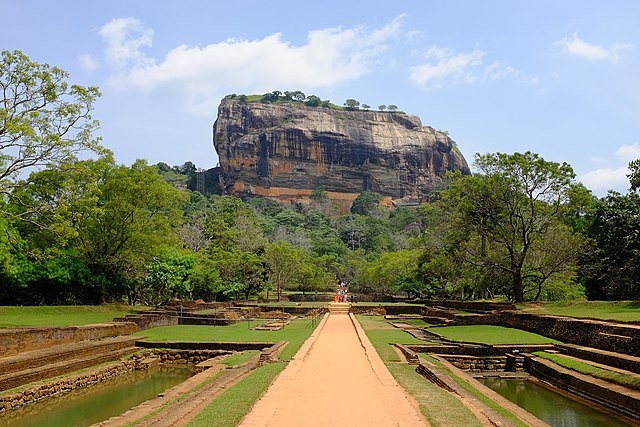
After immersing yourself in the cultural richness of Kandy, it’s time to journey to Sigiriya, a UNESCO World Heritage Site and one of Sri Lanka’s most iconic landmarks. Known as the "Lion Rock," Sigiriya is a massive rock fortress that rises dramatically from the surrounding plains. Over the next three days, you’ll explore ancient ruins, climb to breathtaking viewpoints, and discover the fascinating history of this archaeological wonder.
Day 22: Travel to Sigiriya and Explore the Village
How to Get from Kandy to Sigiriya:
- By Bus: Take a bus to Dambulla (2.5 hours), then a tuk-tuk to Sigiriya (30 minutes). This is the cheapest option, costing around 5–5–10.
- By Private Taxi: A 2.5-hour drive costing around 50–50–60.
Highlights of Sigiriya Village:
- Local Life: Take a walk through the village to experience the daily life of locals. Visit small shops, interact with villagers, and learn about their traditions.
- Elephant Safari: Head to the nearby Minneriya National Park or Kaudulla National Park for an elephant safari. These parks are known for their large herds of elephants, especially during the dry season (July–September).
- Sunset at Pidurangala Rock: For a less crowded alternative to Sigiriya Rock, hike up Pidurangala Rock to enjoy stunning sunset views of Sigiriya and the surrounding landscape. The hike takes about 30–45 minutes and costs around $3 for entry.
Where to Stay in Sigiriya:
- Budget: Sigiriya Village Hotel – A charming eco-friendly resort with rustic accommodations.
- Mid-Range: Hotel Sigiriya – A comfortable hotel with a pool and views of Sigiriya Rock.
- Luxury: Water Garden Sigiriya – A luxurious resort with stunning villas and a serene atmosphere.
Day 23: Climb Sigiriya Rock Fortress

Highlights of Sigiriya Rock:
- The Climb: The ascent to the top of Sigiriya Rock takes about 1–2 hours, depending on your pace. The climb involves steep staircases and narrow pathways, but the views from the top are worth every step.
- Frescoes: Halfway up the rock, you’ll find the famous Sigiriya frescoes, ancient paintings of celestial maidens that have survived for over 1,500 years.
- Mirror Wall: This polished wall was once so reflective that the king could see himself as he walked by. Today, it’s covered in ancient graffiti left by visitors over the centuries.
- Lion’s Paw Gateway: Near the summit, you’ll pass through the remains of a giant lion statue, which once served as the entrance to the fortress.
- Summit Views: At the top, you’ll be rewarded with panoramic views of the surrounding jungle, villages, and distant mountains.
Tips for Climbing Sigiriya:
- Start Early: Begin your climb early in the morning to avoid the midday heat and crowds.
- What to Bring: Wear comfortable shoes, bring plenty of water, and don’t forget your camera.
- Entry Fees: The entrance fee for Sigiriya Rock is $30 per person.
Day 24: Explore Dambulla and Ancient Caves
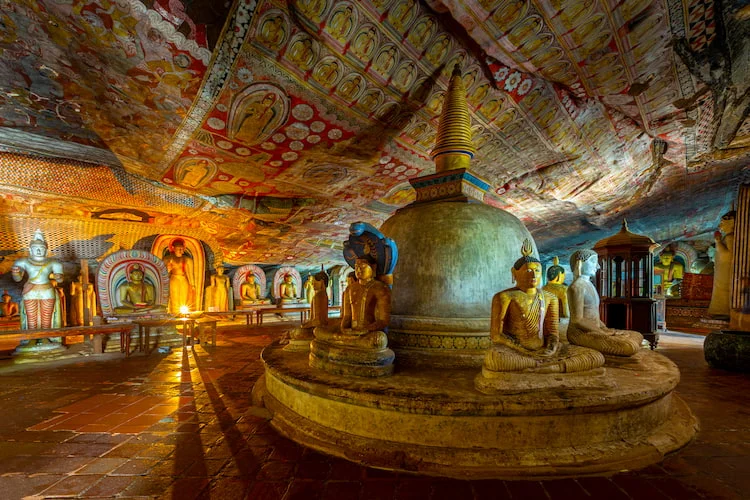
Highlights of Dambulla:
- Dambulla Cave Temple: A UNESCO World Heritage Site, this temple complex features five caves filled with over 150 Buddha statues and intricate murals. The climb to the caves takes about 20 minutes and offers great views of the surrounding area.
- Golden Temple: Located at the base of the cave temple, this modern temple features a massive golden Buddha statue and a museum.
- Local Markets: Explore the bustling markets in Dambulla to shop for fresh produce, spices, and souvenirs.
Where to Eat in Sigiriya/Dambulla:
- Sigiriya Village Restaurant: Offers a mix of Sri Lankan and international dishes in a rustic setting.
- Ranch House Sigiriya: Known for its delicious rice and curry and friendly service.
- Dambulla Dedduwa Restaurant: A great spot for authentic Sri Lankan cuisine.
Tips for Exploring Sigiriya
- Best Time to Visit: Early morning or late afternoon is the best time to climb Sigiriya Rock, as the weather is cooler and the light is ideal for photography.
- Transportation: Tuk-tuks and taxis are the most convenient ways to get around Sigiriya and nearby attractions.
- Packing Tips: Bring a hat, sunscreen, and a reusable water bottle to stay hydrated during your explorations.
- Respect Local Culture: When visiting religious sites like the Dambulla Cave Temple, dress modestly and remove your shoes before entering.
Why Spend Time in Sigiriya?
Sigiriya is a destination that combines history, adventure, and natural beauty. Whether you’re climbing the iconic rock fortress, exploring ancient caves, or enjoying a safari, these three days in Sigiriya will leave you in awe of Sri Lanka’s rich heritage and stunning landscapes.
Day 25–27: Historical Wonders in Anuradhapura
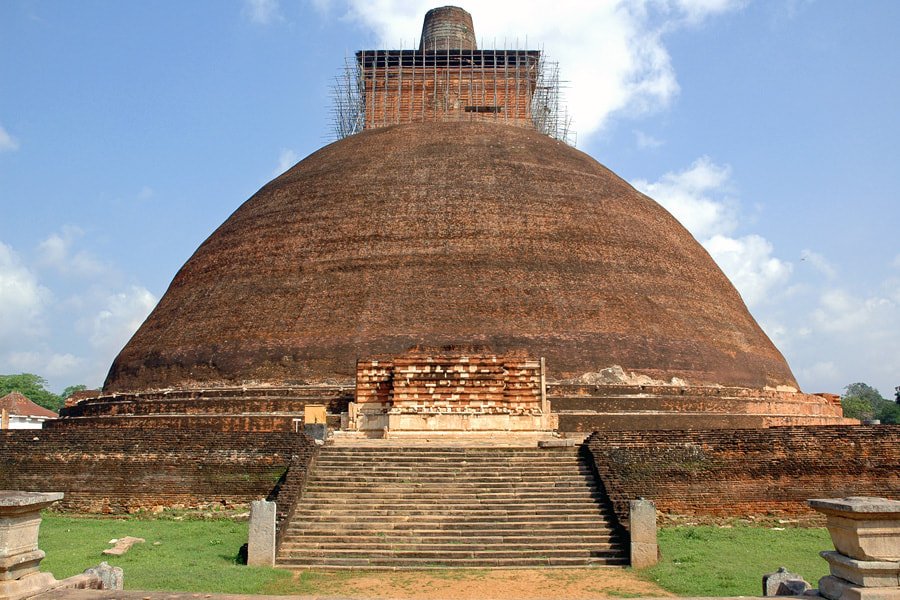
After exploring the iconic Sigiriya Rock and the ancient caves of Dambulla, it’s time to journey to Anuradhapura, one of Sri Lanka’s oldest and most sacred cities. A UNESCO World Heritage Site, Anuradhapura was the first capital of ancient Sri Lanka and is home to some of the country’s most impressive archaeological and religious sites. Over the next three days, you’ll step back in time as you explore ancient stupas, sacred temples, and sprawling ruins that tell the story of Sri Lanka’s rich history and spiritual heritage.
Day 25: Travel to Anuradhapura and Explore the Sacred City
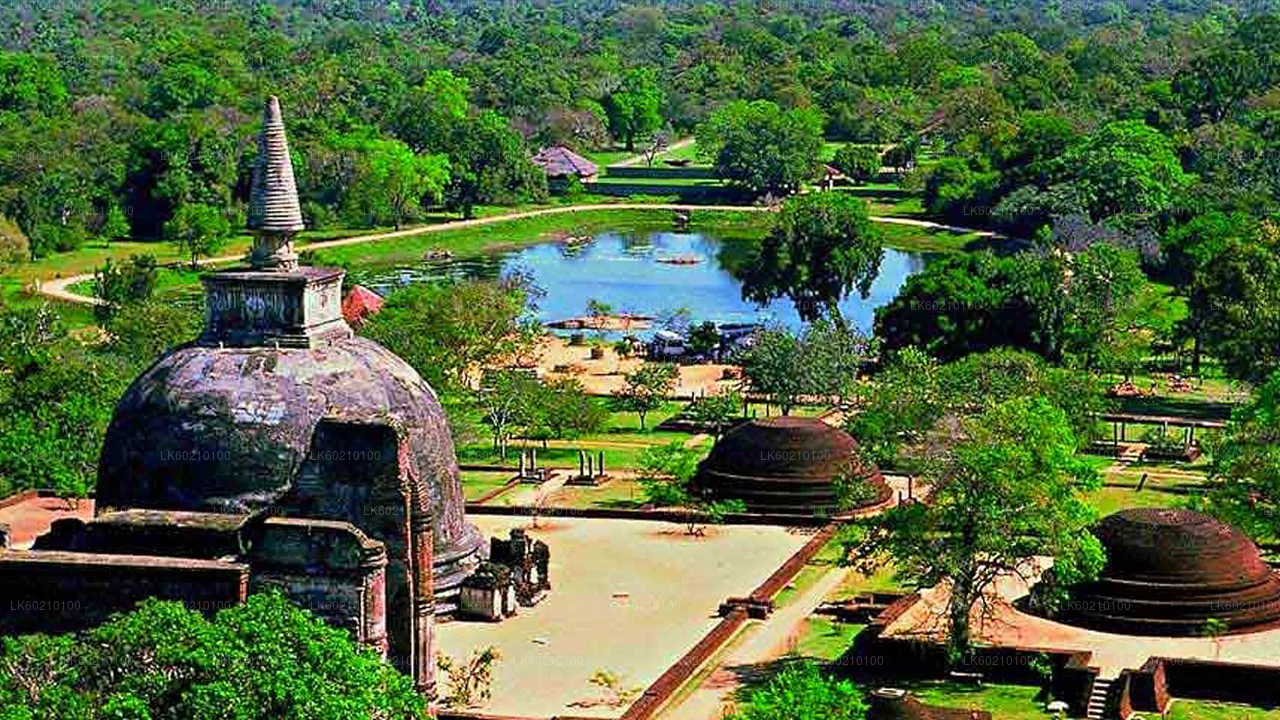
How to Get from Sigiriya to Anuradhapura:
- By Bus: Take a bus to Dambulla (30 minutes), then another bus to Anuradhapura (2.5 hours). This is the cheapest option, costing around 5–5–10.
- By Private Taxi: A 2.5-hour drive costing around 50–50–60.
Highlights of Anuradhapura:
- Sacred Bodhi Tree: Located in the Maha Bodhi Temple, this sacred fig tree is said to be a sapling from the original Bodhi Tree under which the Buddha attained enlightenment. It’s one of the most revered sites in Sri Lanka.
- Ruwanwelisaya Stupa: This massive white stupa is one of the most iconic landmarks in Anuradhapura. Built in the 2nd century BCE, it’s a masterpiece of ancient engineering and a symbol of Sri Lanka’s Buddhist heritage.
- Jetavanaramaya Stupa: Once one of the tallest structures in the ancient world, this brick stupa is an impressive sight and a testament to the architectural prowess of the Anuradhapura Kingdom.
Where to Stay in Anuradhapura:
- Budget: Miridiya Lake Resort – A budget-friendly option with comfortable rooms and a serene lakeside location.
- Mid-Range: Rajaro Resort – A charming resort with a pool and lush gardens.
- Luxury: Ulagalla Resort – A luxurious eco-resort offering villas with private pools.
Day 26: Explore More Ancient Sites and Temples
Highlights:
- Abhayagiri Monastery: Once a major monastic complex, Abhayagiri is home to the Abhayagiri Stupa, ancient bathing ponds, and meditation platforms. The site offers a glimpse into the daily life of monks during the Anuradhapura period.
- Isurumuniya Temple: Known for its rock carvings and serene atmosphere, this temple is a great place to relax and reflect. Don’t miss the famous Isurumuniya Lovers carving.
- Mihintale: Located about 30 minutes from Anuradhapura, Mihintale is considered the birthplace of Buddhism in Sri Lanka. Climb the 1,840 steps to the summit for stunning views and to visit ancient temples and stupas.
Where to Eat in Anuradhapura:
- Mango Mango: A popular restaurant offering a mix of Sri Lankan and international dishes.
- The Sanctuary at Tissawewa: Known for its delicious rice and curry and peaceful setting.
- Mihiri Restaurant: A great spot for traditional Sri Lankan cuisine.
Day 27: Relax and Reflect
Highlights:
- Tissa Wewa: A large reservoir built during the Anuradhapura period, perfect for a leisurely stroll or a picnic.
- Archaeological Museum: Learn more about the history and significance of Anuradhapura’s ancient sites through artifacts, models, and exhibits.
- Evening at Ruwanwelisaya Stupa: Spend your final evening in Anuradhapura visiting the Ruwanwelisaya Stupa at sunset. The stupa is beautifully illuminated at night, creating a magical atmosphere.
Tips for Exploring Anuradhapura
- Best Time to Visit: Early morning or late afternoon is the best time to explore the ancient sites, as the weather is cooler and the light is ideal for photography.
- Transportation: Rent a bicycle or hire a tuk-tuk to get around the sprawling archaeological site.
- Dress Code: When visiting religious sites, dress modestly and remove your shoes before entering.
- Packing Tips: Bring comfortable walking shoes, a hat, sunscreen, and plenty of water.
Why Spend Time in Anuradhapura?
Anuradhapura is a destination that offers a deep connection to Sri Lanka’s ancient history and spiritual heritage. Whether you’re marveling at towering stupas, exploring ancient monasteries, or reflecting under the sacred Bodhi Tree, these three days in Anuradhapura will leave you with a profound appreciation for Sri Lanka’s rich cultural legacy.
Day 28–30: Unique Charm of Jaffna
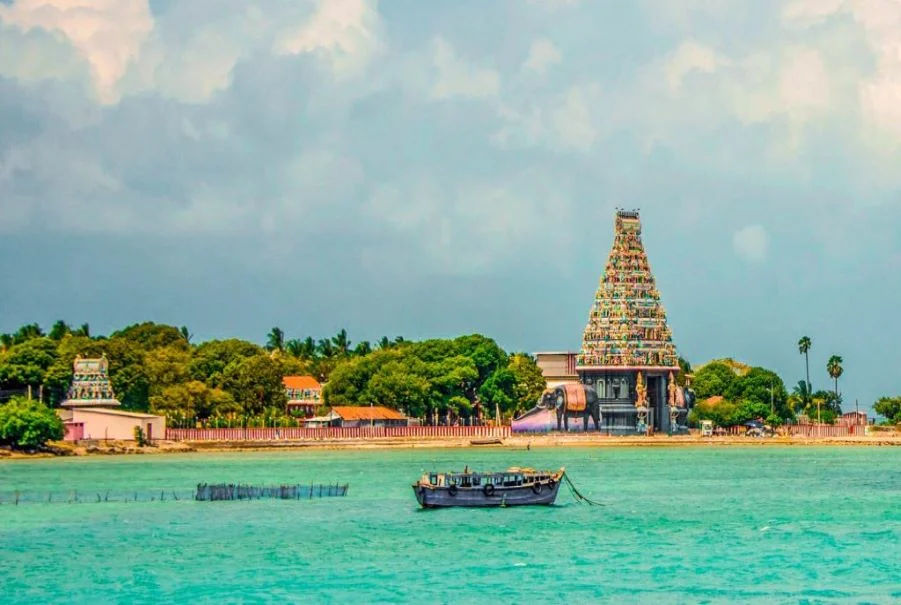
After exploring the ancient wonders of Anuradhapura, it’s time to head north to Jaffna, a city that offers a unique cultural experience unlike any other in Sri Lanka. As the capital of the Northern Province, Jaffna is known for its rich Tamil heritage, vibrant traditions, and stunning landscapes. Over the next three days, you’ll immerse yourself in the local culture, explore historic landmarks, and savor the unique flavors of Jaffna’s cuisine.
Day 28: Travel to Jaffna and Explore the City
How to Get from Anuradhapura to Jaffna:
- By Train: The train ride from Anuradhapura to Jaffna takes about 4–5 hours and offers scenic views of the northern countryside. Tickets cost around 5–5–10 for second class.
- By Bus: Public buses are cheaper (around $5) but take longer (6–7 hours).
- By Private Taxi: A 4-hour drive costing around 70–70–80.
Highlights of Jaffna:
- Jaffna Fort: Built by the Portuguese in the 17th century and later expanded by the Dutch, this fort is one of the largest in Sri Lanka. Explore its ramparts, moat, and colonial-era architecture.
- Nallur Kandaswamy Temple: One of the most important Hindu temples in Sri Lanka, this stunning temple is dedicated to Lord Murugan. Visit during the annual Nallur Festival (July–August) to witness vibrant processions and rituals.
- Jaffna Market: A bustling market where you can shop for fresh produce, spices, and traditional Tamil handicrafts.
Where to Stay in Jaffna:
- Budget: Jetwing Jaffna – A stylish and affordable hotel with modern amenities.
- Mid-Range: The Thinnai – A boutique guesthouse offering comfortable rooms and a warm atmosphere.
- Luxury: Fox Jaffna – A luxurious hotel with a rooftop pool and stunning views of the city.
Day 29: Explore Jaffna’s Cultural and Natural Attractions
Highlights:
- Jaffna Public Library: A symbol of resilience and knowledge, this library was rebuilt after being destroyed during the civil war. It’s a must-visit for history and architecture enthusiasts.
- Nagadeepa Purana Vihara: A sacred Buddhist temple located on Nagadeepa Island, accessible by a short boat ride. The temple is believed to have been visited by the Buddha during his lifetime.
- Casuarina Beach: A serene beach located about 20 kilometers from Jaffna, perfect for a relaxing afternoon. The shallow waters and soft sand make it ideal for swimming and picnics.
Where to Eat in Jaffna:
Find the best hotel deals for your next trip! Compare prices and book your stay on
Hostelworld: Meet fellow travellers — save on stays, Backpacker-friendly hostels, verified reviews and social stays that fit your budget and vibe.
Tripadvisor: Plan with confidence — reviews you can trust, Restaurants, hotels and experiences with millions of traveller reviews to help you choose what’s best.
Traveloka: Flights, hotels & more — simple booking, One-stop travel platform for great flight fares, hotel deals and local activities across Asia and beyond.
- Mangos: A popular restaurant offering a mix of Sri Lankan and international dishes.
- Rio Ice Cream: Known for its delicious homemade ice cream and fresh fruit juices.
- Green Grass Hotel: A great spot for traditional Jaffna cuisine, including crab curry and dosas.
Day 30: Day Trip to Delft Island

Highlights of Delft Island:
- Dutch Fort Ruins: Explore the remains of a 17th-century Dutch fort and learn about the island’s colonial history.
- Wild Horses: Delft Island is home to a herd of wild horses, believed to be descendants of horses brought by the Portuguese.
- Coral Walls: Unique coral stone walls built by the Dutch can still be seen on the island.
- Baobab Tree: One of the oldest baobab trees in Sri Lanka, believed to have been brought from Africa by Arab traders.
How to Get to Delft Island:
- Take a ferry from Kurikadduwan Jetty, about 30 kilometers from Jaffna. The ferry ride takes about 1 hour and costs around 5–5–10.
Tips for Exploring Jaffna
- Best Time to Visit: December to March is the ideal time to visit Jaffna, as the weather is dry and pleasant.
- Transportation: Tuk-tuks and taxis are the most convenient ways to get around Jaffna and nearby attractions.
- Dress Code: When visiting religious sites like Nallur Kandaswamy Temple, dress modestly and remove your shoes before entering.
- Packing Tips: Bring a hat, sunscreen, and a reusable water bottle to stay hydrated during your explorations.
Why Spend Time in Jaffna?
Jaffna offers a unique blend of history, culture, and natural beauty that sets it apart from other destinations in Sri Lanka. Whether you’re exploring ancient temples, relaxing on pristine beaches, or savoring the flavors of Tamil cuisine, these three days in Jaffna will leave you with unforgettable memories.
Day 31: Return to Negombo
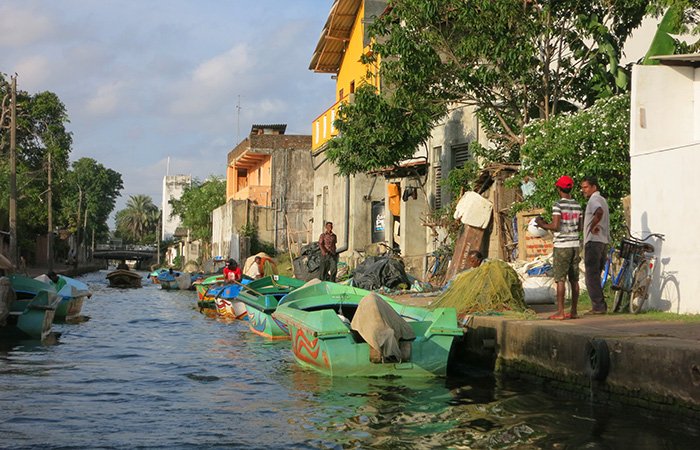
After an incredible month exploring Sri Lanka’s diverse landscapes, rich history, and vibrant culture, it’s time to wrap up your journey and head back to Negombo for your departure. Located just 10 kilometers from Bandaranaike International Airport, Negombo is the perfect place to spend your final day in Sri Lanka. Whether you want to relax by the beach, explore the town’s colonial heritage, or simply reflect on your adventures, Negombo offers a peaceful and convenient end to your trip.
How to Get from Jaffna to Negombo
- By Train: Take a train from Jaffna to Colombo (6–7 hours), then a taxi or bus to Negombo (1 hour). The train ride costs around 5–5–10 for second class.
- By Bus: Direct buses from Jaffna to Negombo take about 8–9 hours and cost around $10.
- By Private Taxi: A 6–7 hour drive costing around 100–100–120.
Highlights of Negombo
- Negombo Beach: Spend your final hours relaxing on the beach, soaking in the sun, and enjoying the sound of the waves.
- Dutch Canal: Take a leisurely stroll or a boat ride along the historic Dutch Canal, which runs through the heart of Negombo.
- St. Mary’s Church: Visit this beautiful Catholic church, known for its stunning frescoes and peaceful atmosphere.
- Negombo Fish Market: If you have time, explore the bustling fish market to see the daily catch and experience the local way of life.
Where to Stay in Negombo
- Budget: Villa Shade – A cozy guesthouse with a garden and affordable rooms.
- Mid-Range: Jetwing Beach – A beachfront hotel with modern amenities and a pool.
- Luxury: The Gateway Hotel – A luxurious option with stunning views of the Indian Ocean.
Tips for Your Final Day
- Relax and Reflect: Use your final day to relax and reflect on your incredible journey through Sri Lanka.
- Pack Early: Make sure to pack your belongings early and double-check your flight details.
- Transportation to the Airport: Most hotels in Negombo offer airport transfers, or you can hire a tuk-tuk or taxi for a short ride to the airport.
Why Spend Your Final Day in Negombo?
Negombo’s proximity to the airport and its laid-back atmosphere make it the perfect place to end your Sri Lanka adventure. Whether you’re relaxing on the beach, exploring the town’s colonial heritage, or simply reflecting on your journey, Negombo offers a peaceful and convenient conclusion to your trip.
Sri Lanka Travel Itinerary: Facts and Figures
- Duration: 1 month
- Budget: 900–900–1,500 (depending on travel style)
- Best Time to Visit: December–March (west and south coasts)
- Transportation: Trains, buses, tuk-tuks, and private drivers
- Visa: Electronic Travel Authorization (ETA) required ($50 for 30 days)
Where to Stay in Sri Lanka on a Budget
Sri Lanka offers a wide range of budget accommodations, from hostels to guesthouses. Here are some tips:
- Hostels: Look for dorms or private rooms in popular backpacker hubs like Ella, Mirissa, and Kandy.
- Guesthouses: Family-run guesthouses are affordable and offer a chance to experience local hospitality.
- Homestays: Stay with a local family for an authentic cultural experience.
Sri Lanka is a budget traveler’s paradise, offering a wide range of affordable accommodations that don’t compromise on comfort or location. Whether you’re looking for hostels, guesthouses, or budget hotels, there are plenty of options to suit every traveler’s needs. Below, we’ve curated a list of top budget accommodations in Sri Lanka’s most popular destinations, complete with booking links to help you plan your stay.
1. Negombo
Negombo is often the first stop for travelers due to its proximity to the airport. It’s a great place to relax and ease into your Sri Lanka adventure.
- Villa Shade
A cozy guesthouse with a garden, comfortable rooms, and a friendly atmosphere. Perfect for budget travelers.
Booking Link: Villa Shade on WayAWay - Jetwing Beach
A beachfront hotel offering affordable rooms with modern amenities and a pool.
Booking Link: Jetwing Beach on WayAway
2. Colombo
Colombo, Sri Lanka’s bustling capital, offers a mix of budget-friendly accommodations in convenient locations.
- Stay Lost & Found
A vibrant hostel with a social atmosphere, perfect for backpackers.
Booking Link: Stay Lost & Found on Booking.com - Clock Inn Colombo
A stylish and affordable hostel with modern amenities and a central location.
3. Galle
Galle is known for its historic fort, stunning beaches, and charming streets.
- The One Apartment
A cozy and affordable option located close to Galle Fort. - Fort Bazaar
A boutique hotel with stylish rooms and a rooftop restaurant, offering great value for money.
4. Weligama
Weligama is a popular spot for surfing and beach lovers.
- Tinara River Inn
A charming guesthouse with a peaceful riverside location and affordable rates. - Mirissa Hostel
A social hostel with a pool and beach access, perfect for budget travelers.
5. Ella
Ella is a hill country gem known for its stunning views and hiking trails.
- Chillout Hostel Ella
A relaxed hostel with stunning views and a social atmosphere. - 98 Acres Resort & Spa
A mid-range option with panoramic views of Ella Gap, offering great value for money.
6. Nuwara Eliya
Nuwara Eliya, known as "Little England," is famous for its tea plantations and cool climate.
- Trevene
A cozy guesthouse with a homely atmosphere and affordable rates. - Heritance Tea Factory
A unique hotel set in a converted tea factory, offering mid-range prices with luxurious touches.
7. Kandy
Kandy is Sri Lanka’s cultural capital, home to sacred temples and lush landscapes.
- Clock Inn Kandy
A stylish and affordable hostel with a central location. - Earl’s Regent
A comfortable hotel with panoramic views of the surrounding hills, offering great value for money.
8. Sigiriya
Sigiriya is famous for its iconic rock fortress and ancient ruins.
- Sigiriya Village Hotel
A charming eco-friendly resort with rustic accommodations and affordable rates. - Hotel Sigiriya
A comfortable hotel with a pool and views of Sigiriya Rock, offering great value for money.
9. Anuradhapura
Anuradhapura is one of Sri Lanka’s ancient capitals, home to sprawling ruins and sacred sites.
- Miridiya Lake Resort
A budget-friendly option with comfortable rooms and a serene lakeside location. - Rajaro Resort
A charming resort with a pool and lush gardens, offering great value for money.
10. Jaffna
Jaffna, in the northern part of Sri Lanka, offers a unique cultural experience.
- Jetwing Jaffna
A stylish and affordable hotel with modern amenities. - The Thinnai
A boutique guesthouse offering comfortable rooms and a warm atmosphere.
Tips for Budget Travelers
- Book in Advance: Secure the best deals by booking your accommodations early, especially during peak travel seasons.
- Use Local Transport: Save money by using public buses and trains instead of private taxis.
- Eat Like a Local: Stick to street food and local restaurants for affordable and delicious meals.
- Travel During the Off-Season: Accommodation prices are lower during the shoulder and off-seasons.
Final Thoughts
This 1-month Lanka itinerary is designed to help you experience the very best of Sri Lanka, from its stunning beaches and lush hills to its rich history and vibrant culture. Whether you’re traveling on a budget or looking for a more luxurious experience, Sri Lanka has something for everyone.
So pack your bags, grab your camera, and get ready for the adventure of a lifetime in the Pearl of the Indian Ocean!
Thank you for following this 1-month Sri Lanka itinerary! We hope it has inspired you to explore this beautiful island and create unforgettable memories. Safe travels and happy adventures!
If you have any questions, leave a comment below or send me a message!
Read More Similar Articles
- Ulaanbaatar Itinerary With The Best Things To Do In Ulaanbaatar
- The Perfect Irkutsk and Lake Baikal Itinerary
- The Perfect 2-Day St. Petersburg Itinerary (Russia) for Families
- Moscow Itinerary: How To Spend 3 Days In Moscow
- Jiri to Everest Base Camp Trek: Hiking Itinerary and Guide
- A Detailed Everest Base Camp Budget Breakdown (+ Infographic)
- Is Sri Lanka Cheap? A Detailed Sri Lanka Travel Budget Guide
